We’ve used Tap Score by SimpleLab to test samples of city and natural water in and around Colorado. In this review, we’ve discussed our experience using Tap Score, including how we found the sample-taking process, what we thought about the results we received, and whether we think Tap Score’s test kits are worth the money.
Table of Contents
🧾 Overview of Tap Score Water Testing Kits
Right off the bat, we’ll say that Tap Score is the best, easiest to use, and most comprehensive water testing product we’ve come across.
We do a whole lot of water testing at WaterFilterGuru. A big part of what we do is testing water filters in our own homes, and to get the best idea of the difference between our unfiltered and filtered water quality, we conduct a before-and-after water test. We now use Tap Score whenever we need to test our water.
Tap Score offers a variety of water tests for city water, well water, and (two new recent additions) rain water and spring water. You can choose between a handful of core tests for each water type, as well as tests for a specific contaminant or contaminants that are commonly found in these water types.
| Test Name | Cost | Type | # of Analytes |
|---|---|---|---|
| Essential City Water Test | $160 | city | 47 |
| Advanced City Water Test | $269 | city | 109 |
| Extended City Water Test | $675 | city | 118 |
| Essential Well Water Test | $195 | well | 48 |
| Advanced Well Water Test | $285 | well | 100 |
| Extended Well Water Test | $810 | well | 106 |
| Essential Rainwater Test | $111 | rainwater | 34 |
| Advanced Rainwater Test | $199 | rainwater | 57 |
| Essential Spring Water Test | $193 | spring water | 43 |
| Advanced Spring Water Test | $290 | spring water | 52 |
| Total Microbiology Water Test | $365 | specialized | 10 |
| 1,4 Dioxane Water Test | $185 | specialized | 1 |
| Full Radiation Water Test | $129 | specialized | 21 |
| PFAS Water Test | $299 | specialized | 18 |
| Coliform Enumeration Water Test | $124 | specialized | 1 |
| Tannins Water Test | $70 | specialized | 1 |
| Aluminum Water Test | $75 | specialized | 1 |
| Antimony Water Test | $75 | specialized | 1 |
| Arsenic Water Test | $75 | specialized | 1 |
| Barium Water Test | $75 | specialized | 1 |
| Benzene Water Test | $185 | specialized | 1 |
| Beryllium Water Test | $75 | specialized | 1 |
| Cadmium Water Test | $75 | specialized | 1 |
| Chromium Water Test | $75 | specialized | 1 |
| Copper Water Test | $75 | specialized | 1 |
| E. Coli Water Test | $124 | specialized | 1 |
| Fluoride Water Test | $75 | specialized | 1 |
| Hardness Water Test | $75 | specialized | 1 |
| Iron Water Test | $75 | specialized | 1 |
| Lead Water Test | $75 | specialized | 1 |
| Manganese Water Test | $75 | specialized | 1 |
| Mercury Water Test | $75 | specialized | 1 |
| MTBE Water Test | $185 | specialized | 1 |
| Nickel Water Test | $75 | specialized | 1 |
| Nitrate Water Test | $75 | specialized | 1 |
| Nitrite Water Test | $75 | specialized | 1 |
| Selenium Water Test | $75 | specialized | 1 |
| Sulfate Water Test | $75 | specialized | 1 |
| Turbidity Water Test | $75 | specialized | 1 |
| Uranium Water Test | $75 | specialized | 1 |
| VOCs Water Test | $365 | specialized | 50+ |
| Extended PLUS Water Test | $2,149 | specialized | 200+ |
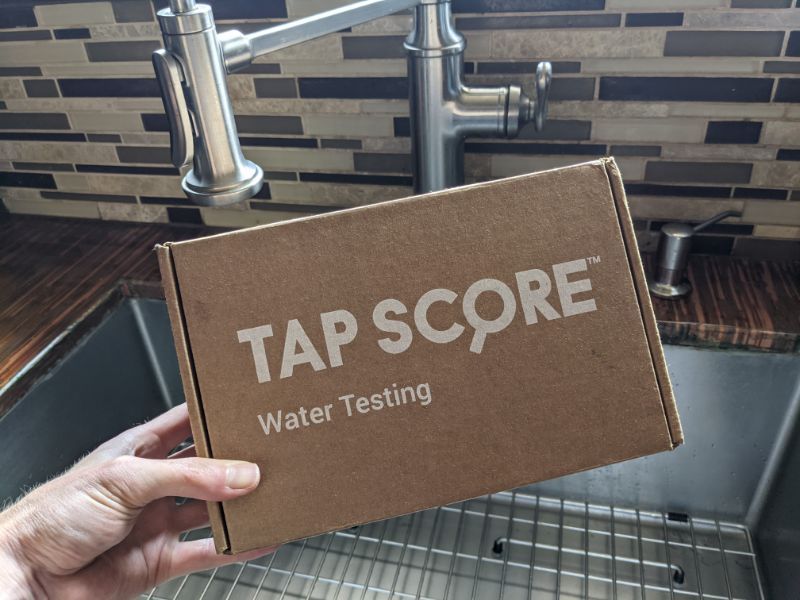
We were impressed with the precision of Tap Score’s testing process and the comprehensiveness of our test results. We found Tap Score’s strict sample-taking protocols a little overwhelming to begin with, but we appreciated knowing exactly what to do (and what not to do) to ensure the accuracy of our test results. We’ve used Tap Score to test city water, well water, and river water, and our average TAT for results was 5-12 days, depending on the type of test we went for.
👍 What We Like
- Multitudes of tests to choose from
- Some of the most comprehensive tests available
- Dedicated city water and well water options
- Easy-to-understand report & data presentation
- Self-serve access to your report
- Quick & easy process from online order to sampling
- Fast turnaround time
👎 What We Don’t Like
- Expensive
- There are A LOT of tests to choose from – this can be overwhelming
- Customer service team not always available
💡 First Impressions
Our first impressions, before we even ordered a Tap Score test, were something along the lines of: “Wow, this is pretty expensive.”
Test prices vary widely, with cheaper tests costing between $50 and $150, and some of the more expensive comprehensive tests costing up to $2,000.
We did a bit of research to understand why Tap Score’s products are on the pricier side. First, Tap Score uses certified labs to do the testing, so there’s an expense involved in shipping the samples to the lab, as well as labor costs from the lab itself. Additionally, Tap Score provides an incredibly detailed interactive lab report (we’ve discussed this later), which offers so much more than a basic water test, and is more informative than any other similar lab test kit we’ve used.
Price aside, we were pleased with the information we found on the Tap Score website. Everything is nicely laid out, and we were able to find the test we needed with just a few clicks. There’s also a handy search bar in the top corner that saved us time when searching for niche tests.
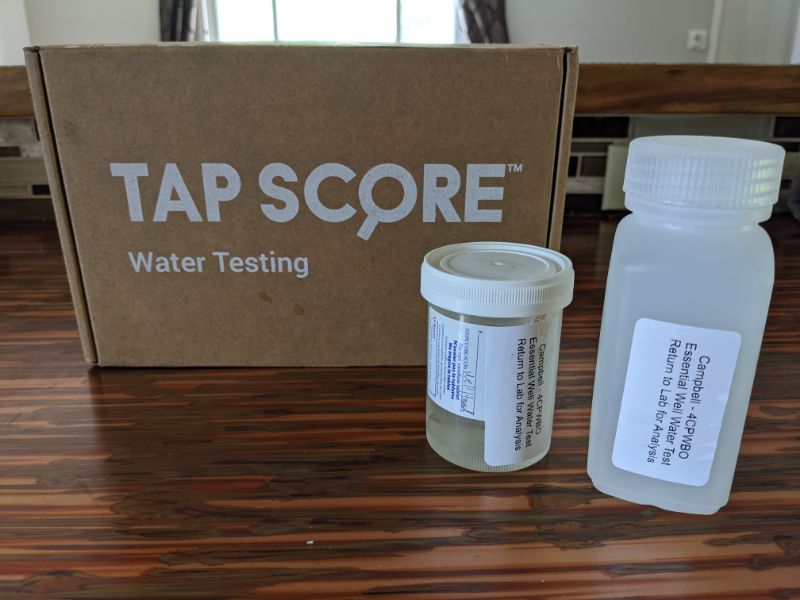
🛒 Ordering A Test Kit
Tap Score is a productized service, which makes life easier from a buyer’s perspective. We could simply click “add to cart” on the tests we were interested in, then checkout once we’d finished shopping.
On the checkout page, we entered the following information:
- Our email address (this is needed so that Tap Score can send the test results to you)
- Our shipping address (to send the test kit)
There’s also an optional Additional Information section. We could check a box to say we were testing a water filter, testing in multiple locations within our home (for which we would need a different test kit for each location), and performing annual maintenance.
Once we’d entered this information, we clicked “Continue to Shipping”, where we could enter delivery instructions if necessary.
The final step was to submit our payment information (Tap Score takes PayPal as well as most common credit cards), then click “Place Order”. We received an email confirmation within a few minutes with our order details. And that was it – we now had to wait for our sampling kit to get shipped to us.

🧪 The Sample-Taking Process
The idea of a lab test like Tap Score is that you take your own sample of tap water, then ship the sample to a lab, which does the testing for you.
We were keen to know how the sample process worked, including how simple we’d find it, and whether there was anything unusual about the sample-taking instructions.
Once we’d ordered our test kit, we waited a couple of days for it to arrive in the mail. It was packaged in a cardboard box, with two sample vials – a plastic bottle and a glass vial – for collecting our water samples. Be careful not to damage the box, as this is the same box you’ll be returning your samples in.

There was also a Sampling Guide, which was a small booklet that talked us through the sampling process. We found the sample instructions super easy to follow, but there are quite a few guidelines that will ensure the most accurate testing process, so these are important to keep in mind as you go.
We also had a few specific instructions from Tap Score when taking our filtered versus unfiltered water tests, which included filling a bucket with water and swirling it around to make sure it was properly mixed before using the water in the filters we were testing. It took a moment to get familiar with everything we needed to do, and we were a bit worried about messing up and tainting a sample – you only have one shot! But once we’d taken a couple of samples, we’d got the process nailed.

💡 TAT & Our Results
As we mentioned, unlike with DIY kits, you don’t have to do any of the testing yourself with a Tap Score kit. Once we’d taken our sample, we mailed it back to the Tap Score lab and waited for our results.
Turnaround time depends on the type of test you’ve ordered. From our experience, most tests have a 5-day turnaround, but some of the trickier tests (such as tests for certain strains of bacteria, mold, and viruses, as well as radiologicals) have a longer TAT of 8-12 days.
You won’t get your results instantly, and this wasn’t a problem for us. But if you’re worried that your tap water supply has been contaminated and is dangerous to drink, our advice is to switch to bottled water until your results are delivered to you.
Regardless of what water quality test we’ve used, Tap Score always delivers the results in the same way: in an interactive report that’s sent to whatever email address is entered during the ordering process.

📊 The Report
Tap Score provides an interactive, easy-to-understand report that you can access privately online from an email.
The first page of our report included details of the date of our tap water sample, a water test score out of 99, and overall scores on our water health, aesthetics, and plumbing.

Once we clicked through into the report, we entered the All Results page, where were able to see exactly what our tap water contained. The type of test you order will determine what shows up on this page.
The report listed the name of each contaminant, its detection (in parts per billion/ PPB or parts per million/ PPM), an “evaluation” of how much of this contaminant is present, and any health or aesthetic impacts it may have.
Contaminants were listed in descending order, with those present in the highest concentrations at the top, and those present in the lowest concentrations at the bottom.

We could click on individual contaminants to bring up more information. We found this handy because it meant we never had to leave the page to do our own research – everything we needed was in front of us.

The report also advised us on the next steps we should take, including additional tests we might want to carry out and the best water treatment options (such as a specific water filtration system) for our contaminant issue.
You can view a sample Tap Score report here.
HCLs, MCLs, & More
To provide a better understanding of the possible health risks of the contaminants detected in a water sample, Tap Score lets you compare your data to several different health guidelines, legal limits, and recommendations.
The main benchmarks are:
| Standard | Description | Enforceable? | By Whom? |
|---|---|---|---|
| HGL (Tap Score) | Strictest benchmark, prioritizes public health | No | Tap Score |
| Federal MCL | Legal limit for contaminants in municipal water | Yes | U.S. Environmental Protection Agency (EPA) |
| Federal MCLG | Non-regulatory limit for contaminants in municipal water | No | U.S. EPA |
| California MCL | Legal limit for contaminants in California | Yes | California Department of Public Health |
| California PHG | Public health objective for contaminants in California | No | California Office of Environmental Health Hazard Assessment (OEHHA) |
We were able to toggle between these different benchmarks depending on what we wanted to compare our data to. For us, the HGL is the benchmark that we reference the most, given that it’s stricter than the federal MCL.
If any contaminant in your water exceeds a HGL, MCL, or any other benchmark you select, the concentration of the contaminant is listed in red. Contaminants that are found in trace levels below the benchmark are still listed, but in black font.
As well as viewing the contaminants based on a specific benchmark, we could also choose to view by detection, or by health risk.
Viewing our results by detection gave us a list view of the contaminants detected in our water, starting with those that exceeded the HGL.
Viewing by health risk grouped contaminants based on their possible health risks. Most contaminants end up in multiple groups because they have several possible health risks.
We personally preferred to view our results by detection because it was easier for us to discern exactly what had been detected in our water. If you’re concerned about health effects, these are listed beneath each contaminant for easy viewing.

Results Accuracy
Generally, your Tap Score results should be as close as possible to 100% accuracy. However, there are a few user errors that might affect the accuracy of the results you receive. These include:
- Shipping your samples later in the week, which could lead to delays
- Contaminating the inside of the sample containers or lids by touching them
- Forgetting to record the sample information
- Not following the specific guidelines in the Sampling Guide
The fact that a small user error could affect results accuracy is a setback of Tap Score for us, especially given the price of their test kits. But it’s a setback of using any professional lab – there’s always a risk of unexpected, inaccurate, or difficult-to-interpret test results.
Our advice is to make sure you follow all the sampling instructions carefully. This isn’t the time to wing it!
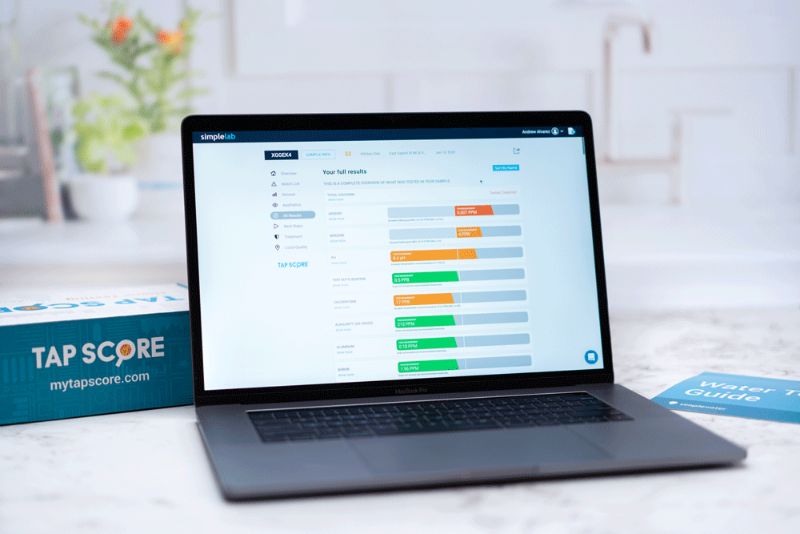
📲 Online Support
We’ve had to use Tap Score’s online support on numerous occasions to help us decipher unusual or unexpected test results, and we’ve consistently found that the support team is very helpful.
Rather than enquiring about our test status and having to wait for a response, we could enter our report ID on the website (here) to instantly know what stage of the testing process our sample was in.
It’s really helpful that they make the information self-serve like this.
We could also live chat with the SimpleLab team, or email the company at [email protected]. This is what we used when we needed help deciphering our results.
Our questions are always pretty complex (for instance, we’ve had some test results show increased concentrations of certain contaminants post-filtration, and we need to figure out why), but we generally receive a comprehensive response, and it’s clear we’re speaking to actual experts rather than folks simply reading off a script. It’s good to know that you’re not simply ignored once you’ve paid for your test and received your results, which is something we’ve experienced with other labs in the past.
Something to keep in mind is that Tap Score’s customer service team only works normal office hours, so we couldn’t speak to a person on live chat super late in the evening or overnight (the team is on PST time).
In some cases, online support might not be necessary, as the FAQs section on the website’s Contact Us page might answer any questions you have, saving you the need to contact a person.
We want everyone to be able to afford peace of mind about their water quality 👉 Click here to get code to save $10 on your first Tap Score test.
🧫 Tap Score’s Tests
We mentioned Tap Score’s tests earlier. If you’re looking for more detailed information on the different tests available, we’ve shared what you should know below.
City Water
When testing your city water, you can choose one of three options:
- Essential City Water Test
- Advanced City Water Test
- Extended City Water Test
The Essential City Water Test tests for physical parameters, nitrates, chlorine and chloramines, and toxic metals.
The Advanced City Water Test tests for all these contaminants, as well as Trihalomethanes and plastic pipe chemicals.
Finally, the most comprehensive test of them all, the Extended City Water Test tests for all of the above, as well as radioactive particles, haloacetic acids, and chlorate.
Tests are priced from around $160 to around $675.
👉 Check out the city water tests here
Well Water
If you purchase a well water test by Tap Score, again, you have three options:
- Essential Well
- Advanced Well
- Extended Well
The Essential Ground Water Test tests for hardness and alkalinity, general chemistry, nitrate and nitrate, toxic heavy metals, silica, and coliform and e.Coli.
The Advanced Ground Water Test tests for all these contaminants, as well as disinfection byproducts, industrial chemicals, and oil and gas indicators.
The Extended Ground Water Test tests for all of the above, and additional oil and gas, tannins, radioactive particles, pesticides and plasticizers, and flame retardants.
Tests range from around $195 and $810.
👉 Check out the well water tests here
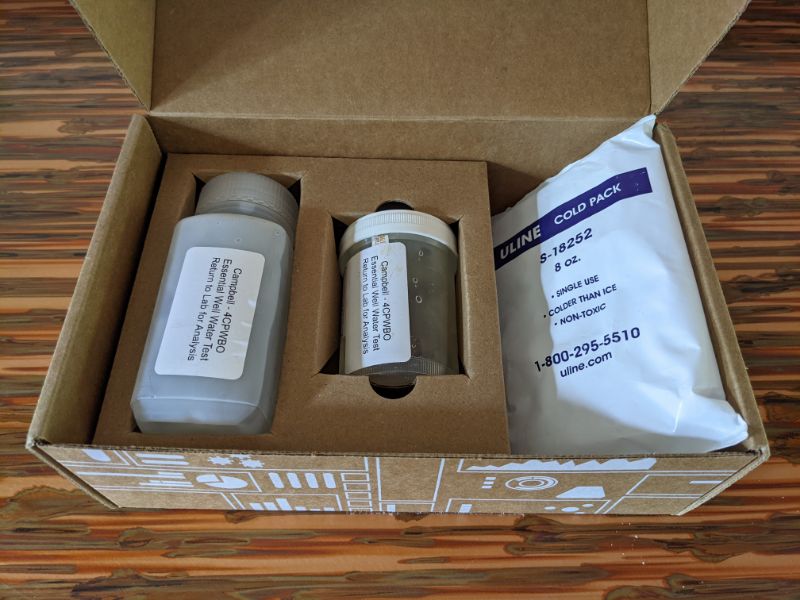
Rain Water
There are two options for rain water tests with Tap Score:
- Essential Rainwater
- Advanced Rainwater
The Essential Rainwater test detects 51 analytes, including metals, minerals, and bacteria.
The Advanced Rainwater test detects 111 analytes, including all those detected in the Essential test, plus additional heavy metals, oil, gas, and BTEX, and other volatile organic compounds.
Tests costs around $190-$285.
👉 Check out the rain water tests here
Spring Water
There are also two options for the spring water tests with Tap Score:
- Essential Spring Water
- Advanced Spring Water
The Essential Spring Water test detects 52 analytes, including bacteria, heavy metals, and non-metal inorganics.
The Advanced Spring Water Test detects all these analytes, plus one extra: total HPC (which gives a reading of total bacteria in water under certain conditions).
The Essential kit starts at around $193, and the Advanced kit costs around $290.
👉 Check out the spring water tests here
Specialized Tests
The Tap Score specialized tests are designed to test for a single contaminant of concern, or multiple contaminants that pose specific exposure risks.
There are 54 tests to choose from, covering everything from the more common impurities (fluoride, bacteria, hardness) to the rarer contaminants (glycol, asbestos, perchlorate).
Tap Score provides information about why you may need to purchase each specialized test on offer.
For example, the perchlorate test is intended for “customers near munitions, rocketry, or industrial waste”, while the nitrate test is ideal for “homes with expecting mothers”.
Tests cost between $50 and $2,000.
👉 Check out the specialized tests here
Add-ons
Finally, you can choose from 8 DIY add-ons, which are at-home self-testing kits that Tap Score recommends using alongside a more comprehensive laboratory test.
There are 5 types of bacteria tests available to buy, as well as testing strips for chlorine, pH, and H2S. Tests range from around $5 to around $50.
You can’t purchase an add-on on its own; it has to be purchased alongside a regular Tap Score water test.
👉 Check out the DIY addon tests here
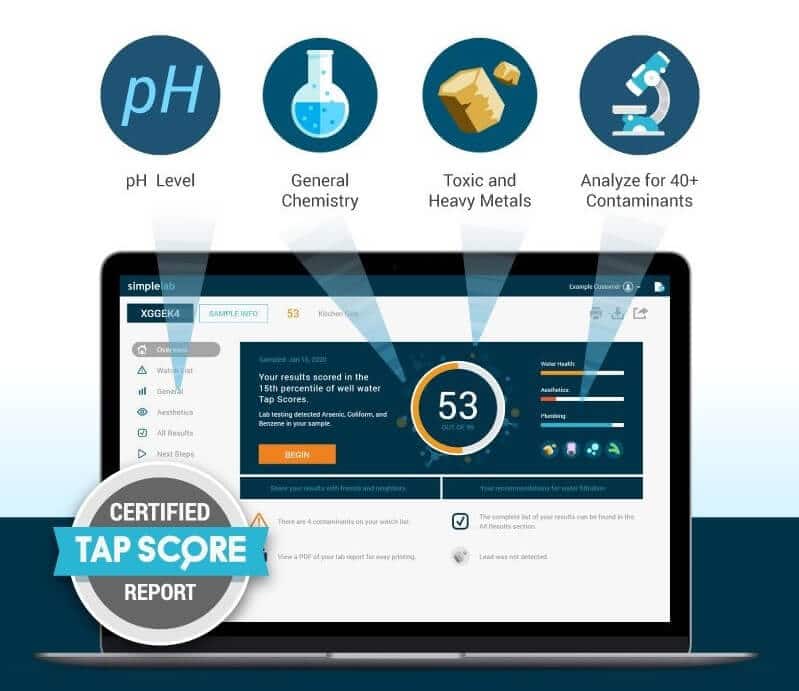
🤔 Is Tap Score The Right Water Testing Service for You?
In our opinion, Tap Score is the best water testing kit available today. We think Tap Score is the best fit for folks who want to get much more comprehensive results than they’d achieve from using DIY kits or test strips at home.
It’s a great option if you have a bigger budget and want a comprehensive overview of the contaminants in your water, and their potential risks. It eliminates the need to do the testing at home, and the sampling process is pretty straight-forward. Getting your drinking water tested by a certified lab means your test data should be accurate, and our Tap Score results
That said, a Tap Score water quality test might not be worth paying for in some scenarios. For instance, if you just want to generally see whether your municipal water supplier is being honest about your tap water quality in your Consumer Confidence Report, or you want to check that a water filter is working to improve your water quality, you might be just as happy to use a more affordable, less accurate DIY test kit.
It totally depends on your budget and what you’re looking for.

